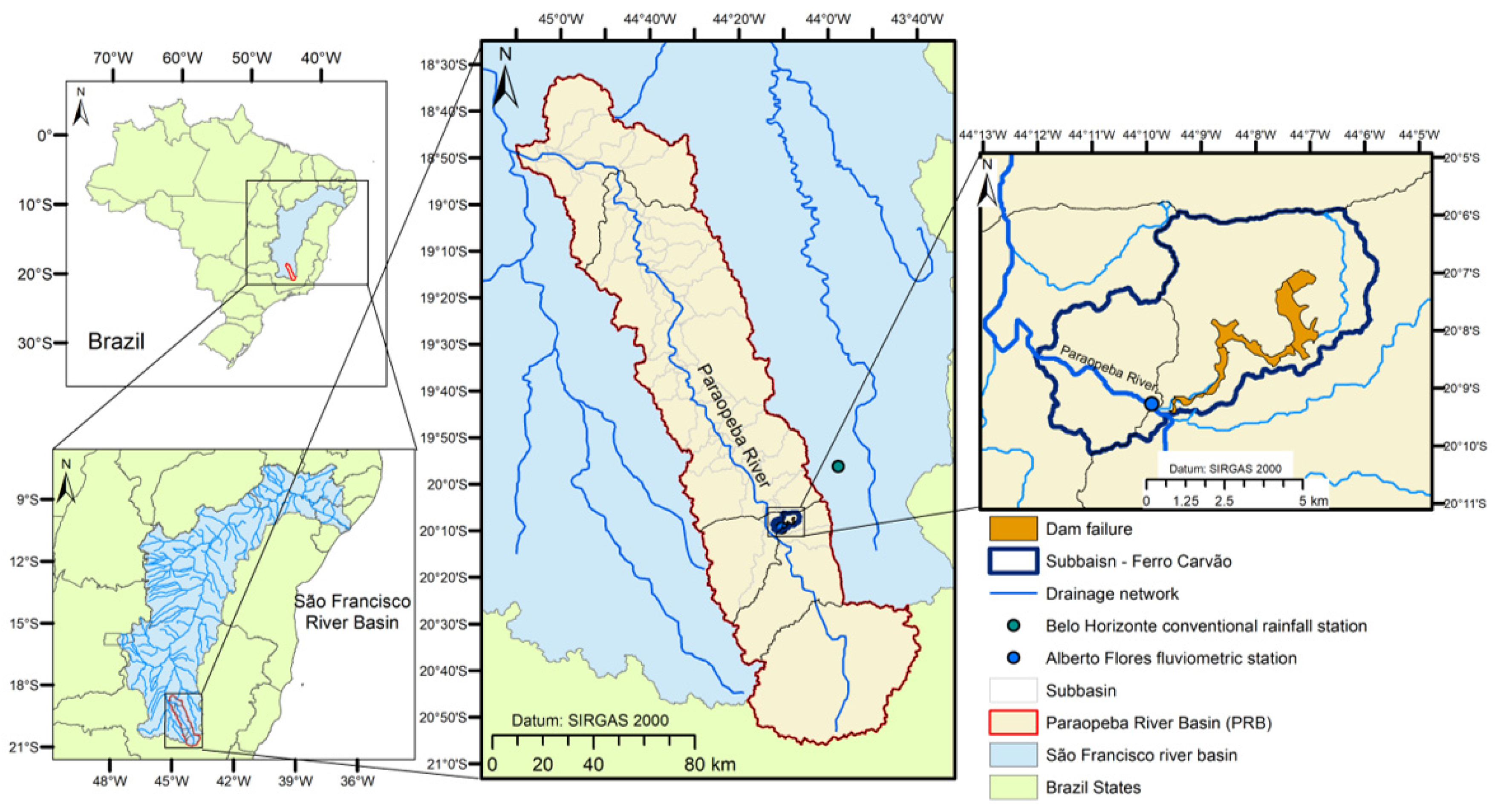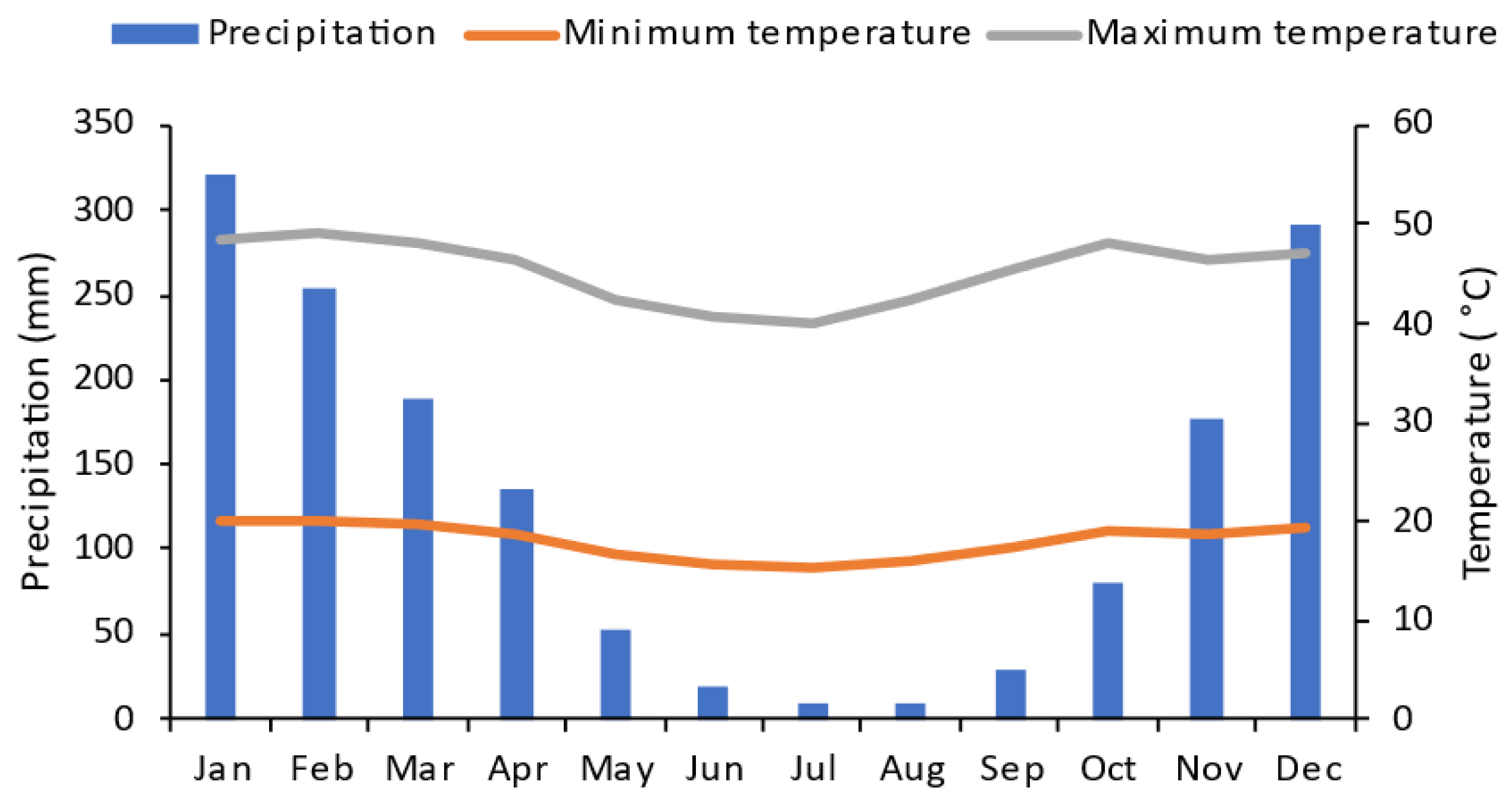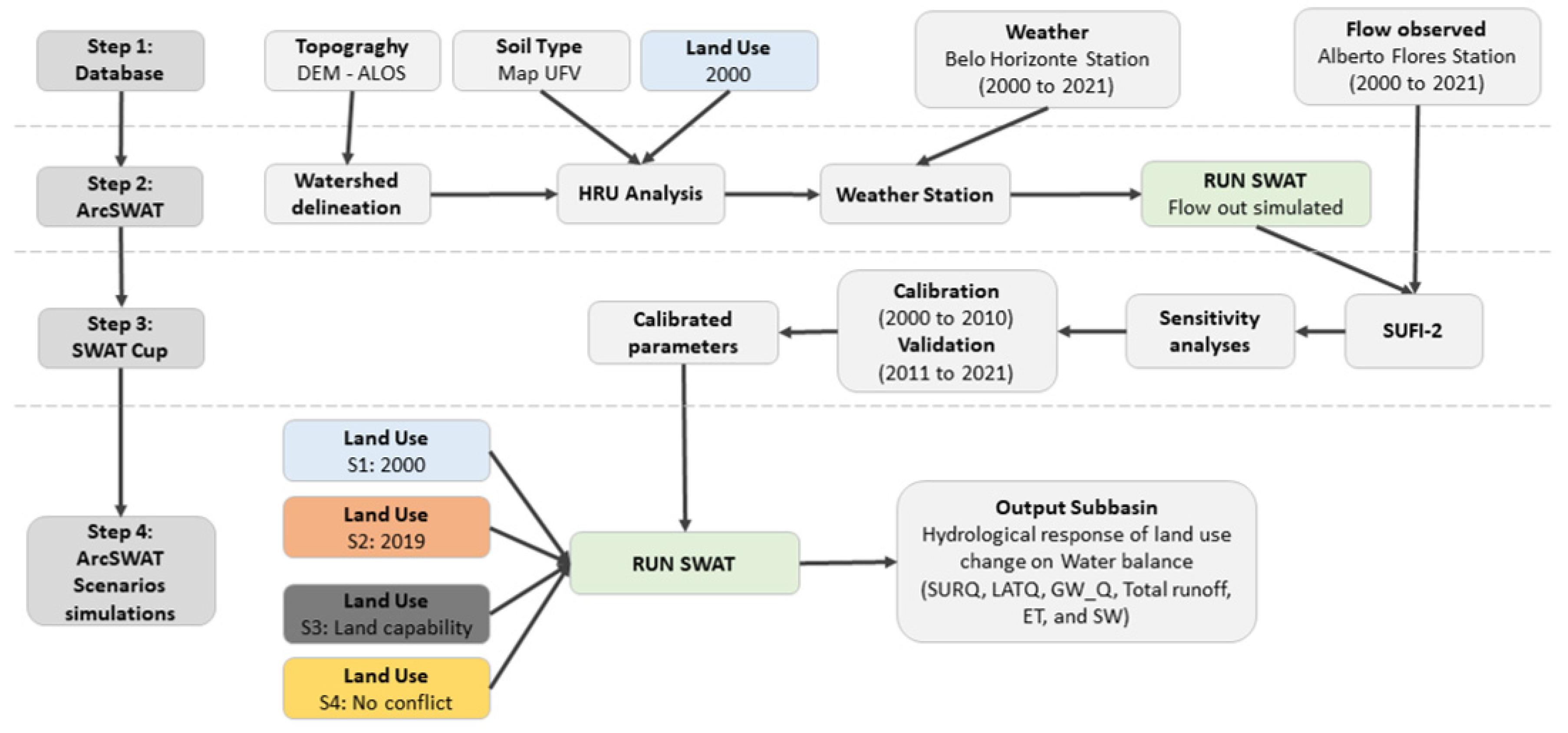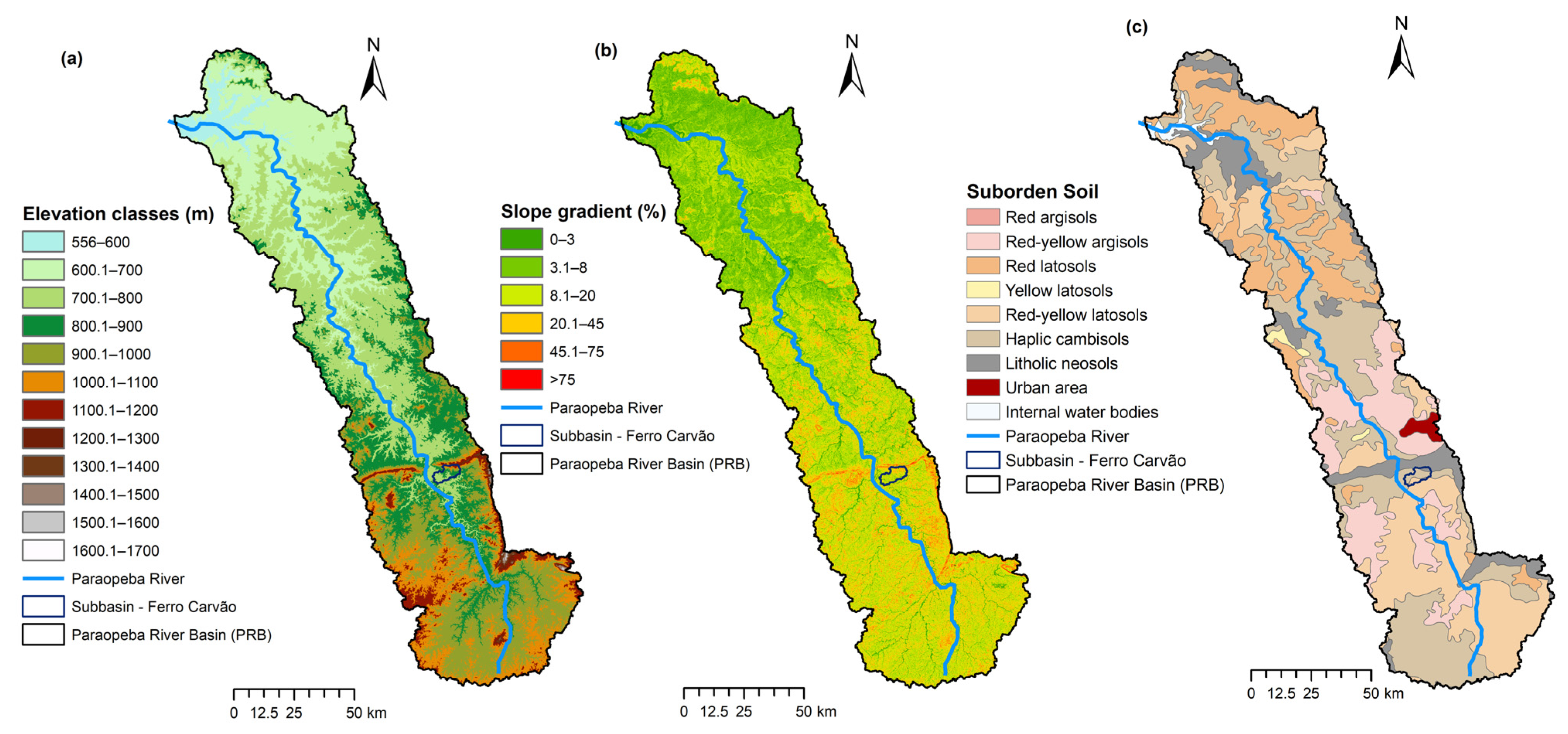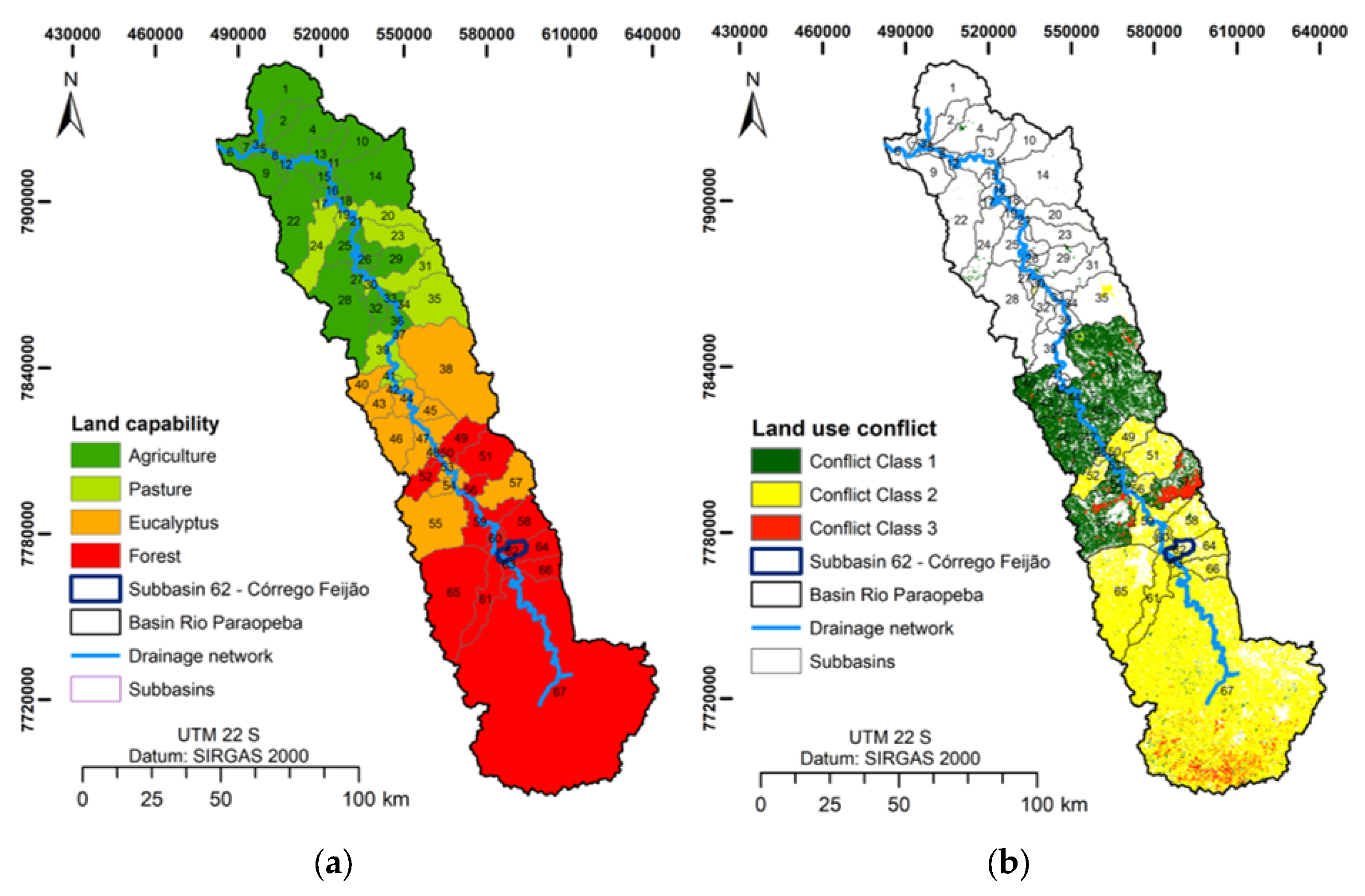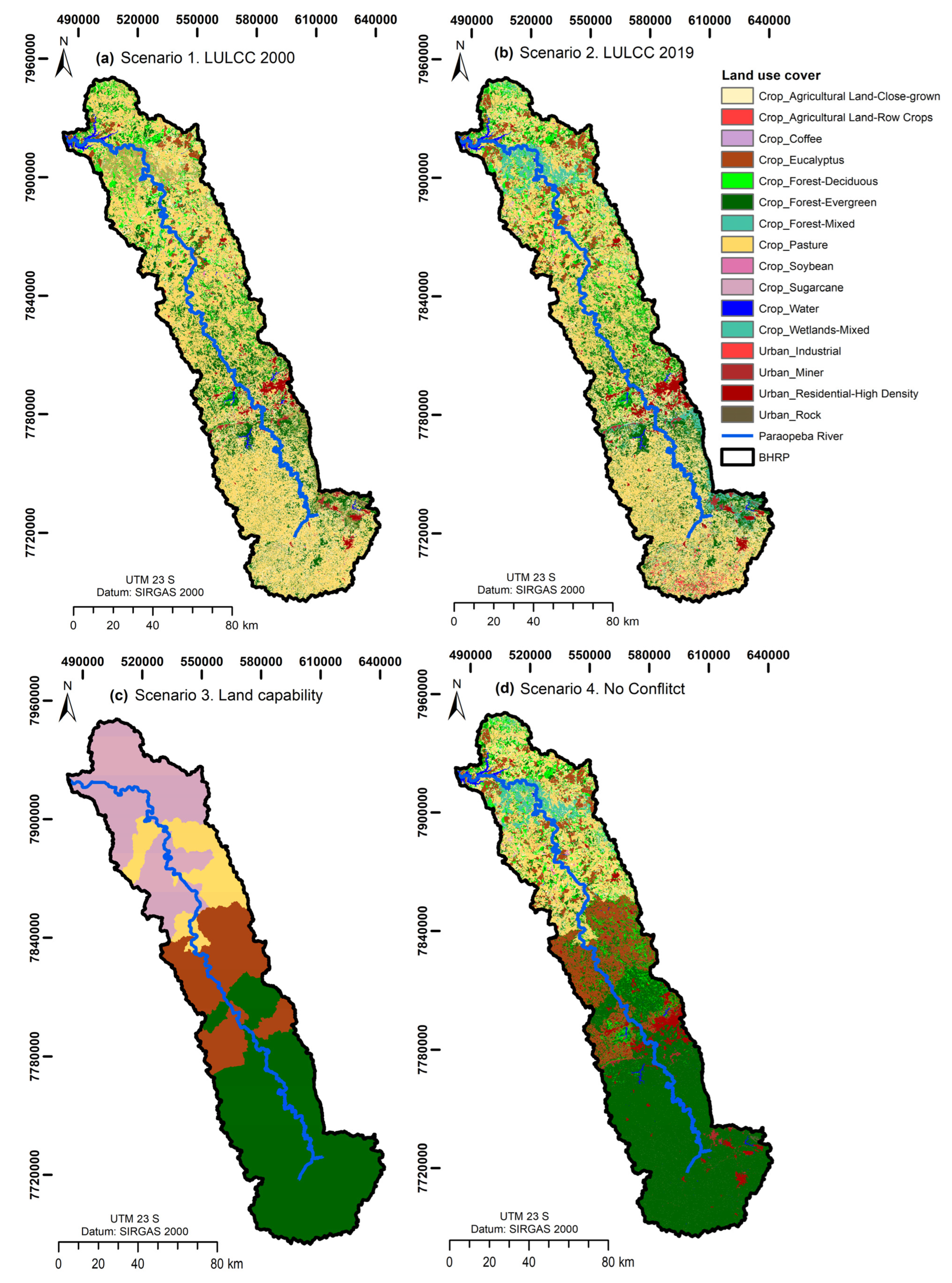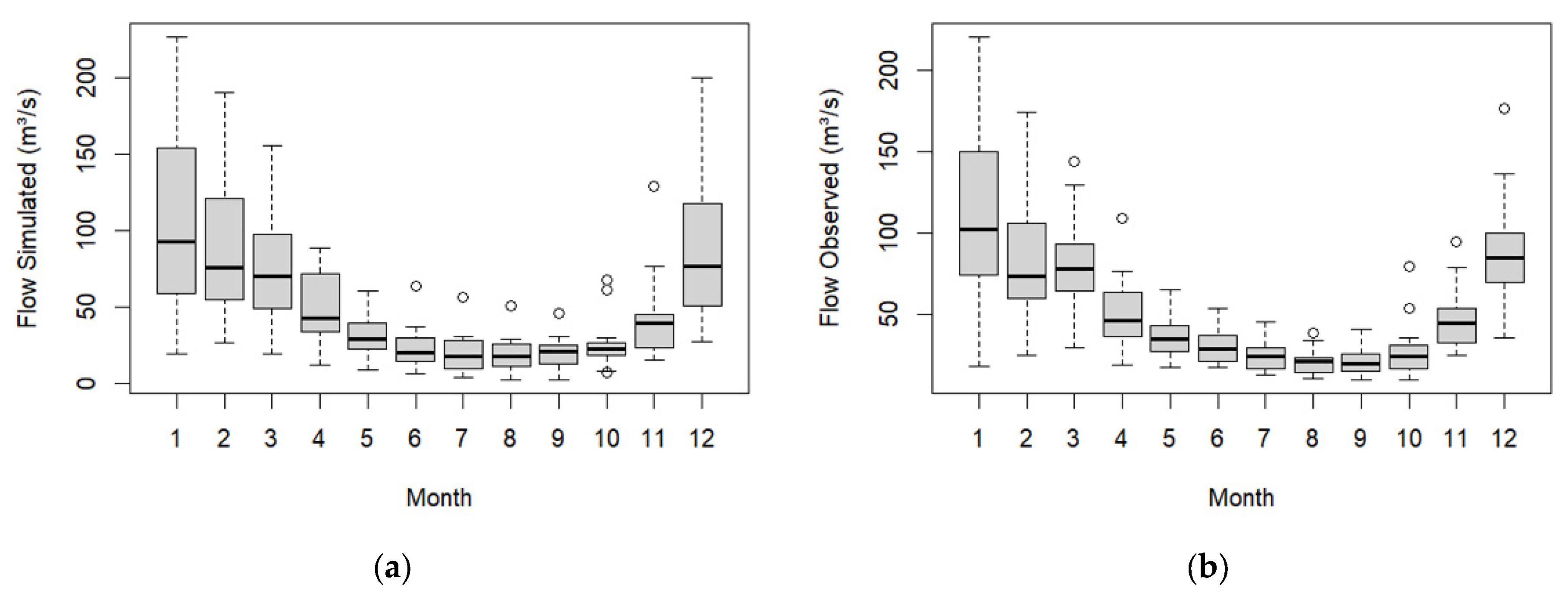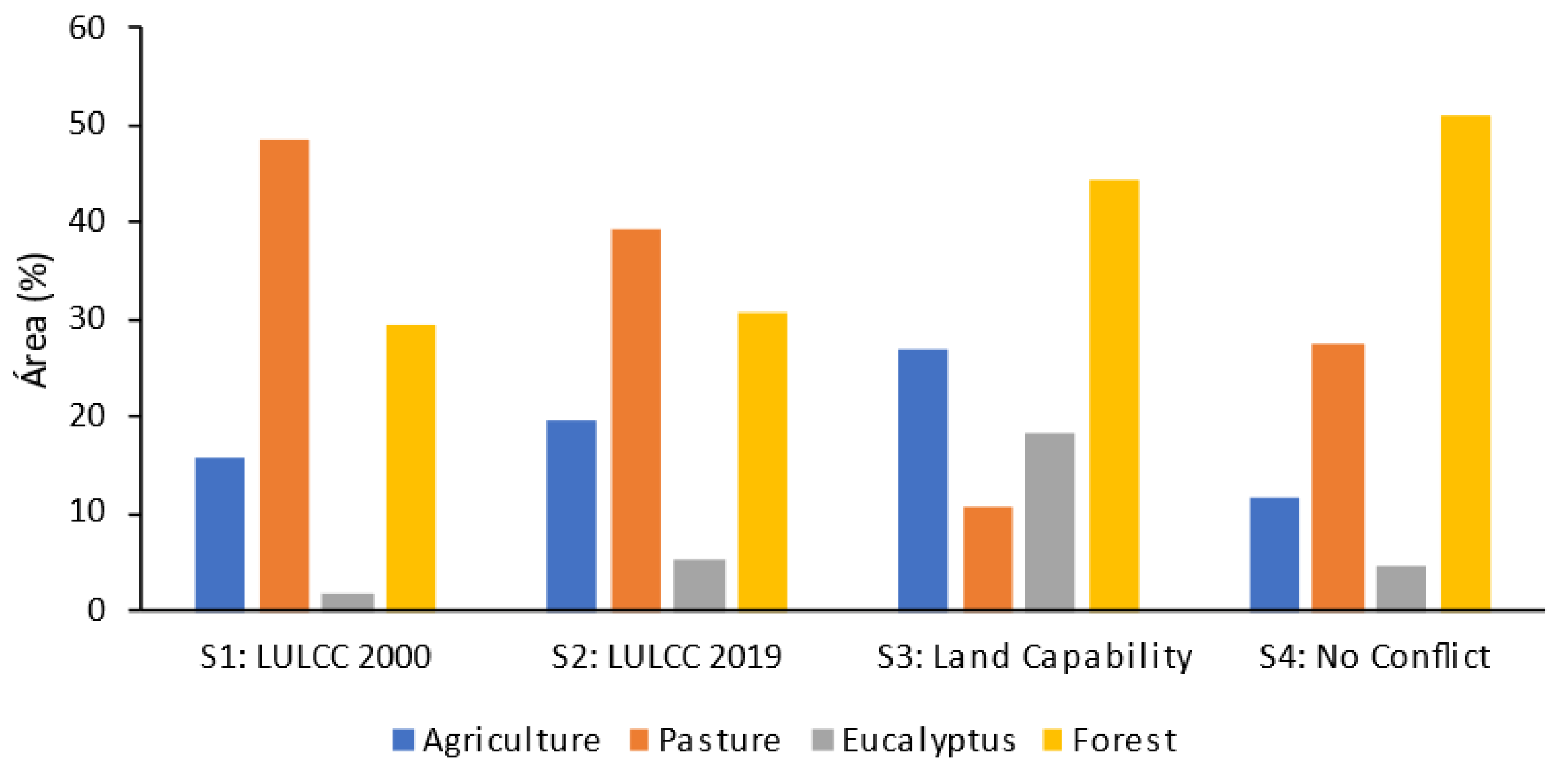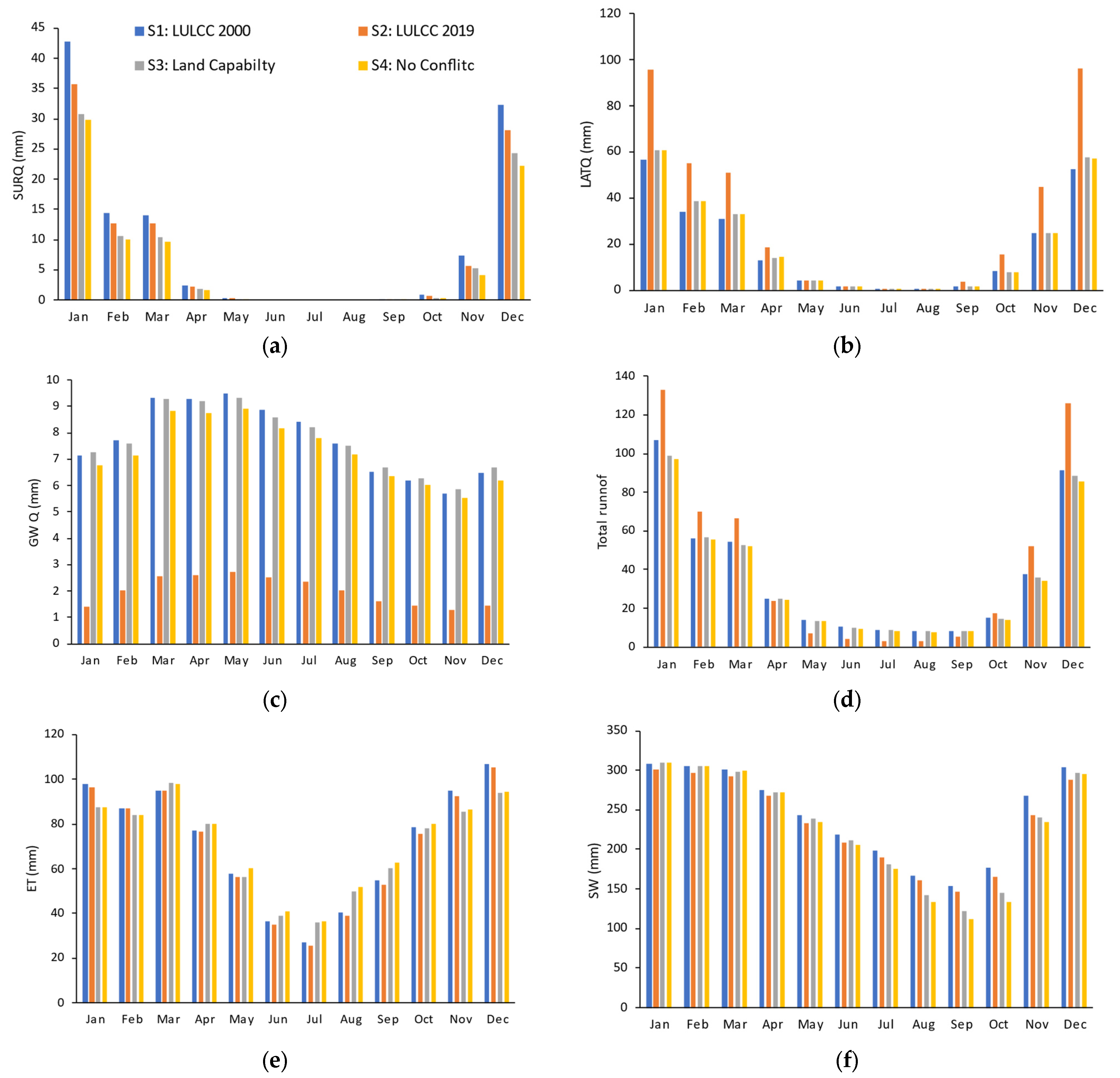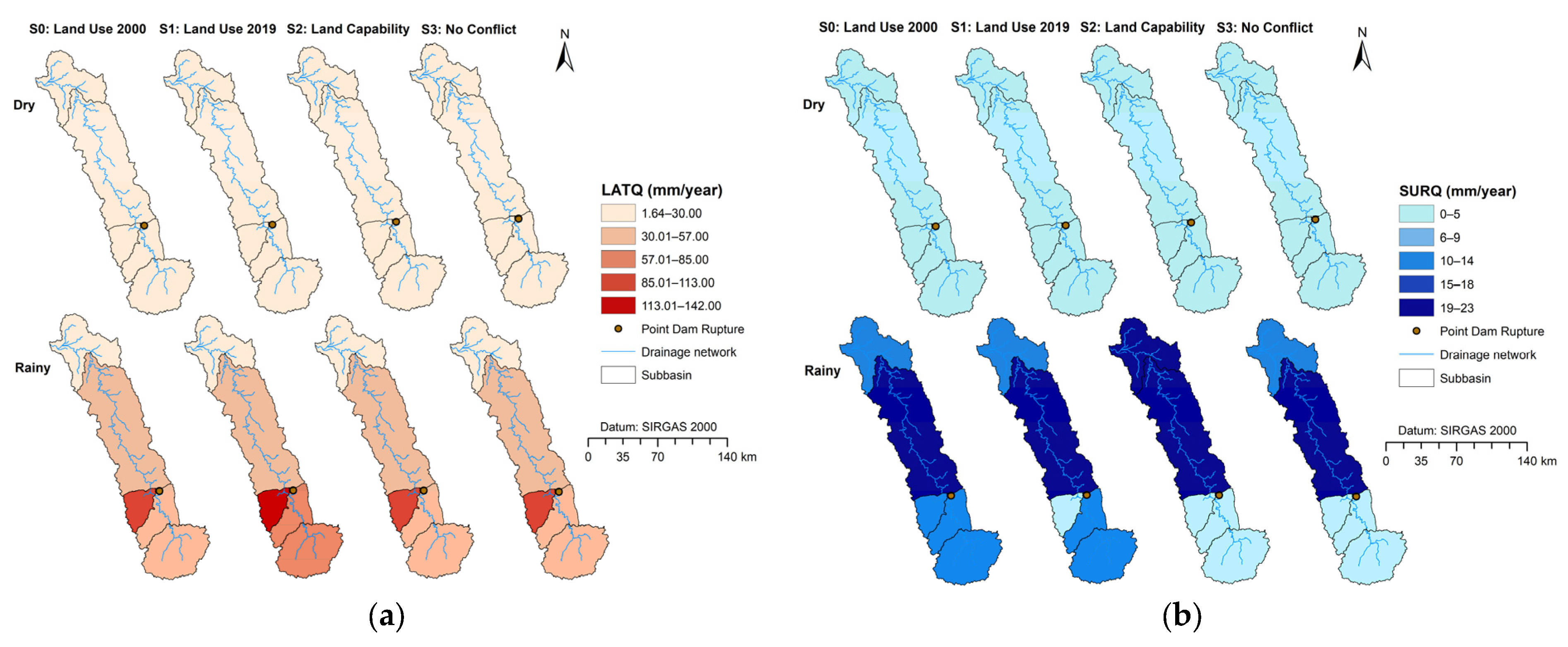2.1. Study Area
The rupture of the B1 dam occurred in the Córrego do Feijão basin, a tributary drain of the Paraopeba River Basin (PRB). The rupture occurred on 25 January 2019, at an altitude of 100 km from its source, resulting in a 200 km impact at the mouth of the Paraopeba River Basin. The basin is located in the southern region of the State of Minas Gerais and flows into the São Francisco River basin, Brazil (
Figure 1). The PRB’s total drainage area is 13,514.94 km
2, comprising practically 48 municipalities and 2,349,024 inhabitants.
The rupture had a serious impact on regional water security. It was necessary to suspend water collection in a 250 km stretch downstream of the rupture. About 16 cities were affected by the dam failure. The Paraopeba River is the source of drinking water for the Metropolitan Region of Belo Horizonte (RMBH) and other cities. The RMBH has 6 million people, and with the disruption, the supply was compromised by 30% [
18,
34].
The amount of water in a given watershed depends on the climate and the conditions of land use and cover in the area considered, which directly influence the seasonal behavior of water flows. Due to its greater latitudinal extension around 300 km, the PRB has heterogeneity in its Hot Central Brazil Tropical Climate, in two climate subtypes according to the Köppen classification, Cwa and Cwb, with a humid temperate climate and a dry winter, and with different processes occurring in the summer period, warm in the Cwa and temperate in Cwb [
35]. The lowest temperatures (15 °C) occur between the months of June, July, and August, and maximum temperatures are >27 °C from September to March [
36]. The average annual precipitation is 2285 mm, with rainy seasons (November to April) and dry seasons (May to October) (
Figure 2).
The pluviometric characterization was carried out with an emphasis on the long-term annual variability in the precipitation. The rainfall regime can be considered one of the most important variables for climate study, in addition to significantly influencing the water balance by affecting the surface runoff regime and the recharge of the aquifers. From 2000 to 2021, the highest precipitation generally occurred from December to March, with values varying between 182.5 mm and 320.38 mm in March and January, respectively. The highest rainfall (134 to 320 mm) occurs in the rainy season, while in the dry season, rainfall varies from 8 to 80 mm per month. The monthly minimum and maximum average temperatures were 18 °C and 27.4 °C, respectively (
Figure 2). The evapotranspiration of the hydrographic basin varies from 665 to 977 mm according to the Master Plan of the Paraopeba Hydrographic Basin [
37].
2.3. Data Base
The SWAT model is a continuous basin scale with time intervals and semi-distributed, simulating hydrological processes [
39]. The identification of variables in the model has a large-scale approach, and the analysis of each HRU was carried out to identify which parameters indicate, positively or negatively, anthropogenic pressure on the PRB ecosystem. Each HRU was parameterized via SWAT using a series of hydrological response units (HRUs), which will be parts of the HRU that have a unique combination of land use/land management, soil, and topography [
29,
40].
For the composition of the database, we used the raster of the Digital Elevation Model (DEM) of the USGS: US Geological Survey
https://search.asf.alaska.edu/# (accessed on 15 April 2022) of spatial resolution 12.5 m, resampled from USGS, and the soil map was obtained from the Soil Map of the State of Minas Gerais
https://dps.ufv.br/softwares/ (accessed on 20 May 2022) with a scale of 1:650,000. For the spatial analysis of elevation and slope, the thematic maps of the PRB basin were processed using the elevation data obtained from the terrain DEM (
Figure 4a). Thematic maps of elevation, slope, and soil suborder are shown in
Figure 4.
For the relief analysis, the slope classes according to the Brazilian Soil Classification System used in the soil mapping units in Brazil [
41] were considered: The relief of the PRB ranges from 0 to 100%, with an average slope of 13%, with a standard deviation of 11%. The wavy relief predominates in the area with 38.3%, occupying 5199.0 km
2 (
Figure 4b,
Table 1).
The soil thematic map was processed from the PRB Soil Classes according to the Brazilian Soil Classification System [
41]. The most predominant soils in the area are Haplic Cambisol (31%), followed by Red-Yellow Latosol (23%) (
Figure 4c,
Table 2). Haplic Cambisols, normally found in strong undulating or mountainous relief, without the existence of a superficial to humic horizon, present variable natural fertility with limitations for use due to the accentuated relief, small depth, and the occurrence of stones in the soil mass. The red-yellow latosols have good permeability, are structured and very porous, have good moisture retention, and are very deep soils located in flat or gently undulating relief. Argisols occur in different climatic conditions and source material and are more common in more rugged and dissected reliefs with less smooth surfaces, making them more susceptible to erosion processes [
41].
The Paraopeba River Basin has a heterogeneous geology and is formed of about 20 main units (
Figure 5a). The predominant geology of the São Francisco Supergroup formation (23.59%) is located downstream of the hydrographic basin. The mining area, where the dam rupture occurred, has a predominance of gneiss formation [
43]. The area has a predominance of the Cristalino hydrogeological domain (fissured aquifer) (
Figure 5b). In this region, there are shales, phyllites, and quartzites. The type of rock does not have primary porosity; the groundwater occurs in the secondary porosity represented by fractures and fissures that form random reservoirs, discontinuous in small areas, and generally have low flows [
44].
2.4. SWAT Model Processing
The model SWAT considers the effects of changes in land use and allows for great flexibility in configuring the proportionality of hydrological phenomena. SWAT made it possible to divide the basin into Hydrological Response Units (HRUs) and is based on the water balance equation [
40], in Equation (1):
where:
SWt—final water content in the soil (mm);
SW0—soil water content (mm);
t—time (days);
Rday—precipitation (mm);
Qsurf—runoff (mm);
Ea—evapotranspiration (mm);
Wseep—water percolation from the simulated layer to the bottom (mm); and
Qgw—lateral flow (mm).
For the initial processing of the model, several periods of the climate database were tested. At the beginning of processing, the land cover was selected for the year 2000—LULCC 2000 (S1). All land use parameters were obtained from the SWAT database. The parameters of native vegetation, eucalyptus, pasture, and agriculture were modified as maximum leaf area index (BLAI), canopy stomatal conductance (GSi), and Manning’s “n” for surface (OV_N) from the SWAT model database to better represent tropical conditions according to Martins (2021). The soil suborder parameters in the SWAT model were characterized according to studies by Baldissera [
32], Freire [
45], Lima [
46], and Moreira [
47]. The input climatic parameters for the SWAT model, such as precipitation, relative humidity, temperature, solar radiation, and wind speed, were obtained from daily historical series of Belo Horizonte conventional rainfall station, from 1 January 1997 to 31 December 2021, obtained from the National Institute of Meteorology (INMET) of the Ministry of Agriculture, Livestock, and Supply (
https://bdmep.inmet.gov.br/ (accessed on 15 August 2022)) in Brazil (
Figure 1). The station was chosen due to its proximity to the PRB zone structural failure and its performance in modeling the PRB water balance. The daily values were processed in the WGN Parameters Estimation Tool software, and the solar insolation data (hour) were converted to solar radiation (MJ/m
2) according to Salati [
48]. The Penman–Monteith equation was used to compute the evapotranspiration in SWAT.
The hydrological calibration of the PRB was carried out using the database obtained from the Alberto Flores fluviometric station (
Figure 1), considering that this area is located as close as possible to the outflow of the zone of structural failure. Historical flow data were obtained from fluviometric stations of the Sistema Nacional de Informação de Recursos Hídricos (SNIRH) and the Agência Nacional de Águas e Saneamento Básico (ANA) (
https://www.snirh.gov.br/hidroweb/serieshistoricas (accessed on 10 June 2022)). For the calibration, the historical series from 1 January 2000 to 31 December 2010 and the validation from 1 January 2011 to 31 December 2021 were used.
The calibration method employs inverse modeling (IM) and indicates physical system inferences based on the flow variable [
49,
50]. Measurements are subject to uncertainties, and inferences are generally statistical in nature. Physical systems use continuous equations, so the inverse hydrological problem is not uniquely solvable. The objective of inverse modeling was to characterize a set of models by assigning uncertainty distributions to the parameters that fit the data and satisfied the assumptions.
The model was calibrated in SWAT-CUP (SWAT Calibration Uncertainty Program), using the Sequential Uncertainty Fitting (SUFI-2) method as an optimization program [
51]. SUFI-2 is a method like the inverse Bayesian, which combines objective function optimization and uncertainty analysis and allows for dealing with a large number of parameters in the calibration of a numerical model. Calibration adjustment used 95 Percent Prediction Uncertainty (95PPU), calculated at the 2.5% and 97.5% levels of the cumulative distribution of an output variable generated by the propagation of parameter uncertainties using Latin hypercube sampling, disallowing 5% of the very bad simulations.
To quantify the fit between the simulation result, expressed as 95PPU, and the observation, expressed as a single signal, two statistics must be adhered to: P factor and R factor [
50,
51]. The P factor is the percentage of observed data involved in the modeling result. The R factor is the thickness of the 95PPU envelope. The value of the P factor varies between 0 and 100%, while that of the R factor varies between 0 and infinity. A P factor of 1 and R factor of 0 make up a simulation that exactly matches the measured data. In the modeling process, the aim was to find the highest P factor (above 0.7) with the lowest R factor (less than 1.2) for flow.
Additional better fit was quantified by R2, Nash–Sutcliff (NS), and PBIAS between observations and the most appropriate final simulation. It is emphasized that the best simulation occurs when the range of the final parameters is within the ideal values of these coefficients. There are no ideal numbers for the response of the R2 or NS coefficients; the higher the value, the better the simulation statistics.
The performance of the model was analyzed using the Nash and Sutcliffe [
52] coefficient (
NS) and the percentage of trends (
PBIAS), Equation (2):
where
is the observation for the constituent being evaluated,
is the simulated value for the constituent being evaluated,
is the mean of the observed data for the constituent being evaluated, and
n is the total number of observations (Equation (2)). The
NS can vary from infinite negative to 1, and the closer to 1, the better the calibration is evaluated.
The percentage of trends (
PBIAS) is calculated by Equation (3), and the closer it is to zero, the better the result.
where
Q is a variable (e.g., flow; flow) and m and s represent measured and simulated, respectively.
PBIAS measures the average tendency of simulated data to be larger or smaller than observations. The optimal value is zero, where low-magnitude values indicate better simulations. Positive values indicate model underestimation, and negative values indicate model overestimation [
53]. Calibration and validation results were classified according to Moriasi [
54].
The SWAT model can safely monitor the discharge of the Paraopeba River Basin. The parameters of the SWAT model for monitoring the risk of flooding and the risk of water scarcity are based on the simulated water volume (flow) for the Paraopeba River.
The model can be used to expand the spatial and temporal monitoring capacity at a lower operational cost. Simulated data can be added to visualization panels for year-round monitoring at any point in the basin. The analysis was carried out based on the range of quartiles for the dry and rainy months of the flow data simulated by the model. The flood risk occurs when the flow in the watershed exceeds the 3rd quartile. When this occurs, the volume of water rises above the river channel and overflow occurs, causing flooding. The risk of water scarcity occurs when the water flow is below the 1st quartile. Low water volume can pose a danger to water availability and increase the risk of increased concentrations of pollutants in the water. The indicators can be used in a dashboard by entities to monitor the Paraopeba watershed.
2.5. Land Use Conflict
For the diagnosis of land capability and the land use conflict in the scenarios, the PRB needed to be compartmentalized into hydrological response units (HRUs). The compartmentation of the PRB into physiographic units was carried out from 33 monitoring points [
36,
55] with the aim of understanding the natural open systems that drain surface water into the thalweg of the Paraopeba River. Each HRU was delineated from the points of higher elevations forming the lines of the topographic dividers and the lines with the points of lower elevations constituting the drainage networks [
13].
The cartographic base of land use was made available by the Annual Land Use and Coverage Mapping Project (
https://mapbiomas.org/ (accessed on 30 April 2022)), in the 2019 image taking, reclassified for land uses of Residential/Industrial, Agriculture, Pasture, and Forestry. The PRB has a predominance of pasture (63%), followed by forest (27%).
The environmental indicator, Ruggedness Number (RN), was introduced by Strahler [
56]. This indicator is used as a morphometric parameter of a watershed to understand the relationship between the total length of the drainage network over a given area (Drainage density (Dd) and Slope (S) (Dd × S)). Therefore, it was possible to compare river basins with this indicator to understand hydrological dynamism [
3,
4,
38]. The model used in the present study defined the land use capability from four classes determined by the Natural Breaks method (Jenks). RN classes were reclassified with capability land use, from smallest to largest, as: agriculture, pasture, forestry, and native forest.
The Land Use Conflict indicator was introduced by Mello Filho and Rocha [
57] and later modified by Valle Junior [
58] and Valle Junior [
59]. According to these authors, the Land Use Conflict (C) classes occur when the land capability (UP) deviates from actual use (UA) (Equation (1)).
For the analysis of deviations between the UP and the UA, the respective identification codes were used. The class actual use (UA) and land capability (UP) were assigned weights, agriculture weight 1, pasture weight 2, forestry/eucalyptus weight 3, and natural forest weight 4, according to Valle Junior [
4,
58]. The mathematical calculation generates negative and zero results, which are classified as regions without Land Use Conflict, and positive results (1, 2, 3) are the levels of conflict. The Conflict class 1 area can be represented by regions where the deviation of an immediately higher class occurs while conflict Class 2 or Class 3 with greater deviations, according to Valle Junior [
4] (
Figure 6).
The land capability of the Paraopeba River Basin (PRB) varies longitudinally (
Figure 6a). The most sloping areas with higher drainage density and forest land capability (44.3%) are located upstream from the PRB, and downstream are the flatter areas with lower drainage density (25.8%). In the central part of the basin, the intermediate pasture and forestry capabilities are located, with 10.5% and 18.3%, respectively.
At PRB, land use conflict occupies almost half of its area (43%), with conflict class 2 being the most common (29%) (
Figure 6b). Conflict class 1 occurs in relief environments, ranging from undulating to heavily undulating, where intensive plant and animal production systems occur. Intensive agriculture presents soil preparation management, farming, and harvesting with an intense use of agricultural mechanization. Therefore, in order to avoid a negative impact on the environment, it is recommended in areas with greater slopes, better management practices, and soil and water conservation. As seen in
Figure 6, the area that presents the greatest conflict (Class 2) is the southern region (upstream of the basin). Class 2 conflict was also predominant in 41% subbasin 62, affected by the dam failure due to the high coefficient of roughness and natural ability to the natural vegetation of the forest.
